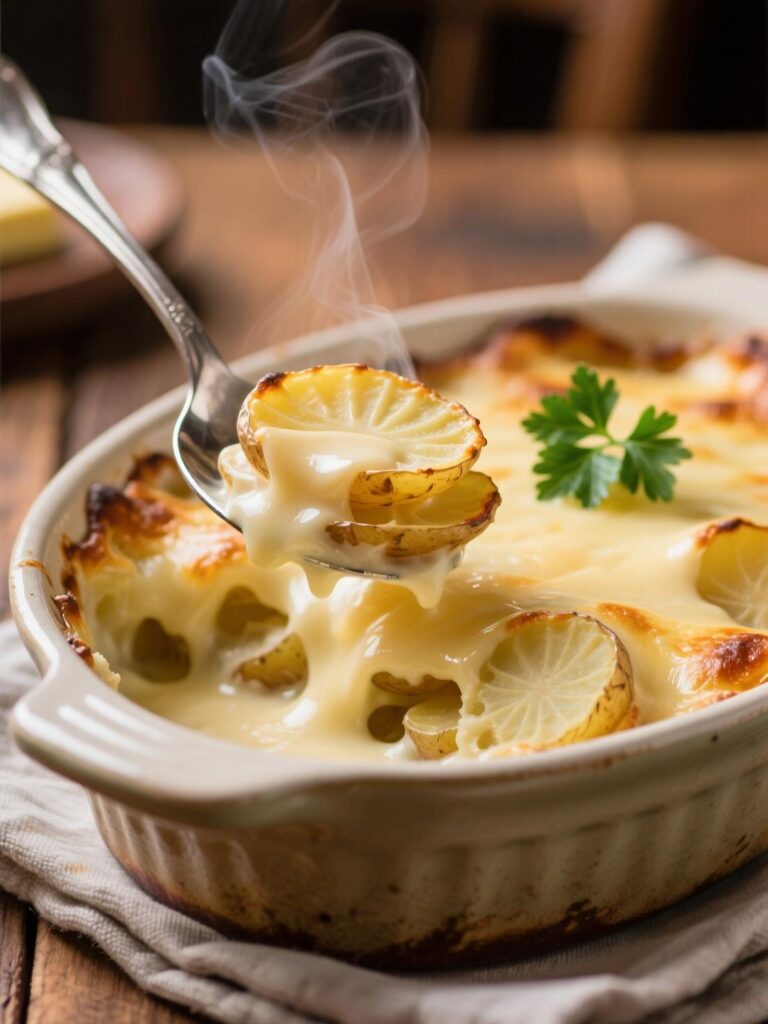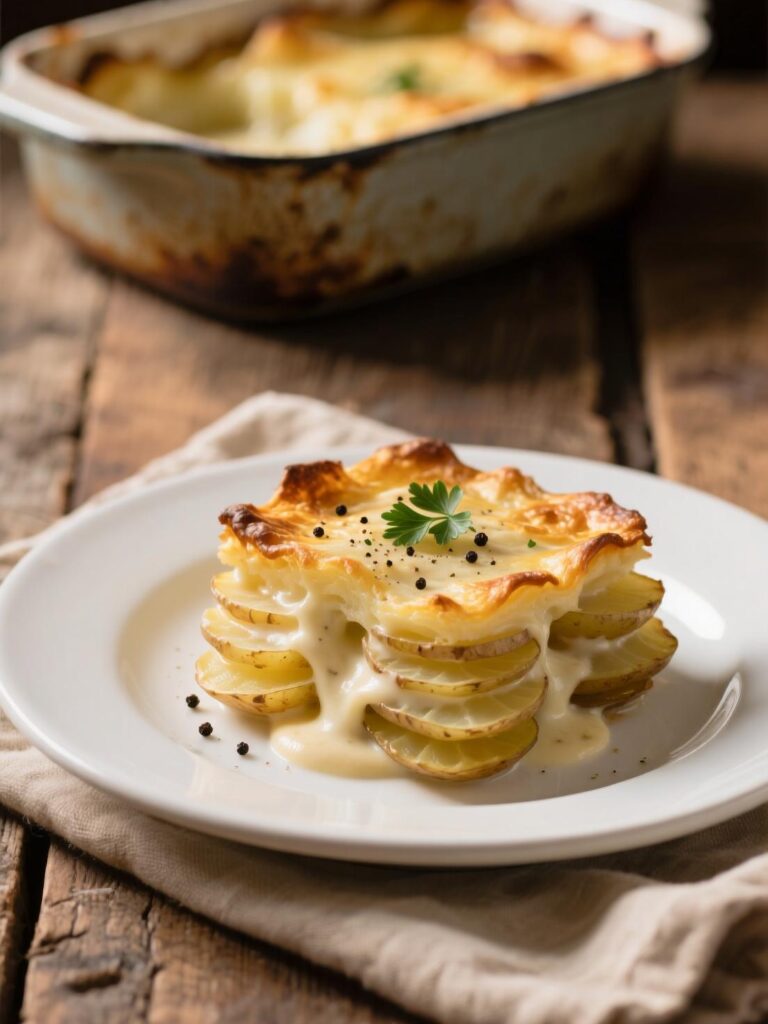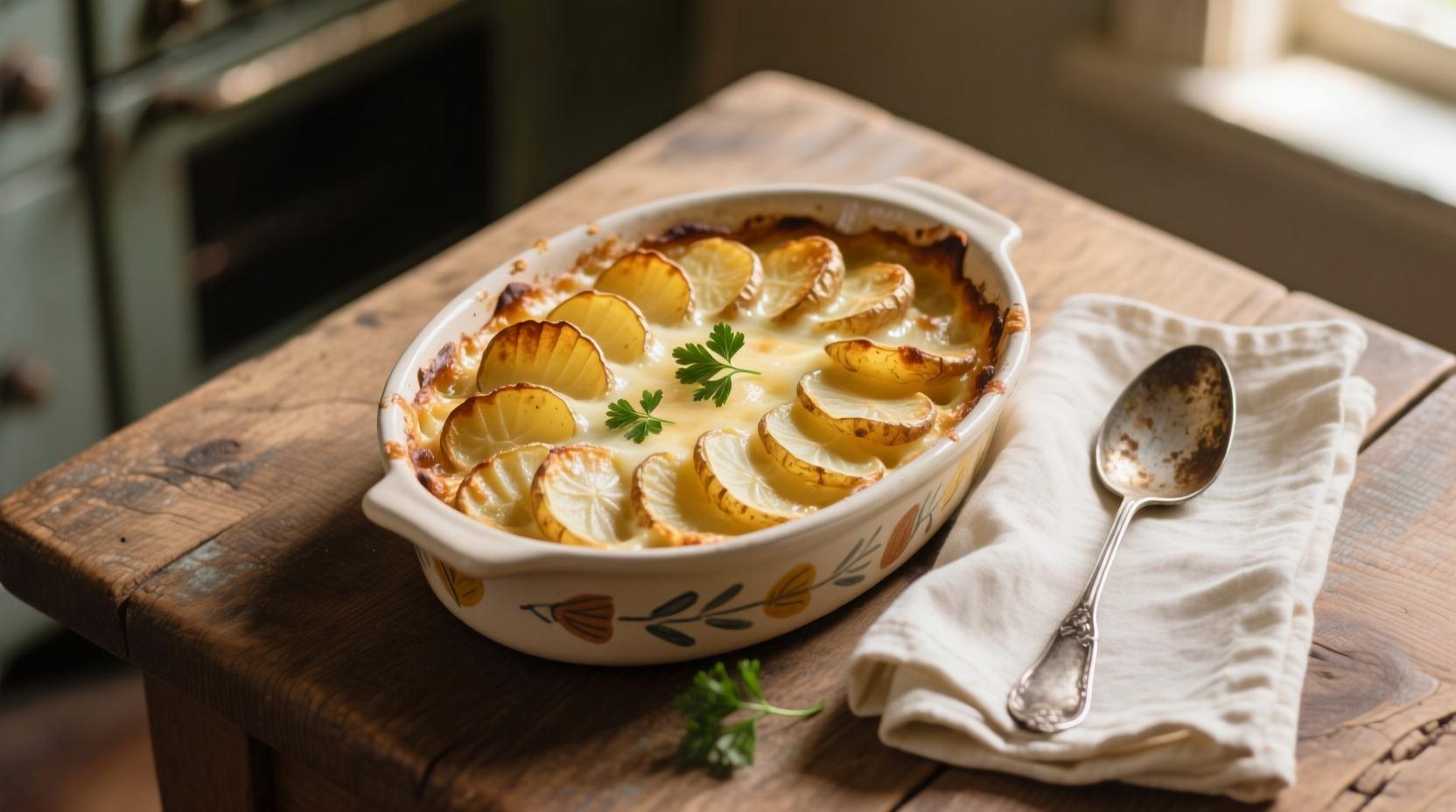The thing about scalloped potatoes? They’re deceptively simple. You see them sitting quietly on a buffet table or nestled beside a roast, yet behind that unassuming look lies a technique that can trip up even seasoned pros. Get them wrong, and you’re stuck with watery sauce and limp spuds. Get them right, and you’ve got a dish that could steal the whole dinner.
If you’re here to just throw cream and potatoes in a dish and hope for the best, this ain’t that. This is an expert’s walk-through — the little temperature tricks, the slicing debates, the starch science — all the bits that elevate scalloped potatoes from decent to devilishly good.
What Exactly Are Scalloped Potatoes?
Let’s be clear. Scalloped potatoes are not potatoes au gratin. No cheese—at least, not in the traditional sense. This dish leans on a milk or cream-based sauce thickened gently by potato starch and a slow bake. The edges caramelize. The layers go soft and silky. It’s all about texture, not cheesiness.
Yet somewhere along the line, home cooks started slipping in cheddar and calling it scalloped. That’s fine if you like bending tradition. But if you want to nail the classic? Hold the cheese till the very end, or better yet, skip it.
Choosing the Right Potato
If you grab a bag of whatever’s cheap, you’ve already lost half the battle. You want a potato with enough starch to thicken the sauce, but not so much it turns gluey.
Russets? They give you a creamier, softer layer because of high starch. Yukon Golds? They bring a buttery note and hold their shape better. Some chefs swear by mixing them—half and half—getting the best of both. In tests, that blend tends to keep structure while still creating that rich mouthfeel.
One thing I tell every new line cook: never use waxy potatoes here. They’ll sit there looking smug, refusing to release starch, and you’ll end up with a watery mess.
Slicing: Precision or Bust
This is the point where a mandoline earns its keep. You’re looking for slices around 1/8-inch thick. Too thin, and they’ll dissolve into mush before the sauce sets. Too thick, and the bake will take forever, leaving raw centers.
Consistency is key. If some slices are thin and others chunky, they’ll cook unevenly. Even Michelin-starred kitchens have been burned by a lazy slice job. If you don’t have a mandoline, take your time with a sharp chef’s knife.

The Sauce: Where Science Sneaks In
Classic scalloped potatoes rely on a béchamel or simple cream sauce. The debate here is whether to thicken the sauce before pouring it over the potatoes or to let it thicken in the oven.
Pre-thickening with a roux (butter + flour) gives you control. The sauce won’t break, and it’ll cling to the potato layers. But there’s a camp of purists who simply heat cream with aromatics and let the potatoes’ own starch do the work. Both methods work, but if you’re serving to paying guests? I lean toward the roux method for consistency.
Seasoning is non-negotiable. Salt, black pepper, a whisper of nutmeg, maybe some garlic if you’re not a purist. Remember—potatoes are bland sponges. Under-seasoning is the number one rookie mistake.
Layering: A Little Drama Never Hurts
Start with sauce at the bottom of the dish—always. Then a single, slightly overlapping layer of potatoes. Season lightly between layers. More sauce. More potatoes. Repeat.
Here’s a trick from French kitchens: press down on the layers with the back of a spatula after every two layers. This compacts the dish, making sure the sauce gets into every nook and cranny. It also prevents gaps that can cause uneven cooking.
Baking: The Low-and-Slow Discipline
High heat might tempt you—it’ll brown the top faster. But that’s a rookie trap. You need low, even heat (325°F–350°F) for at least 60–90 minutes. This lets the starches gently thicken without curdling the cream.
Cover the dish for the first hour. This steams the potatoes. Then uncover to get that golden crust on top. The smell that fills the kitchen at this point is your cue you’re almost there.
And yes, you need a rest period after baking. Fifteen minutes minimum. That’s when the sauce tightens and the layers settle into sliceable perfection.
Common Mistakes Professionals Still Make
1. Using cold sauce – It slows cooking and can cause the cream to split before the potatoes soften. Warm sauce only.
2. Skipping seasoning layers – All the flavor can end up on top instead of throughout.
3. Rushing the bake – Undercooked potatoes are a cardinal sin here. No one forgives a crunchy scalloped potato.
4. Wrong dish depth – Too deep, and the center cooks forever. Too shallow, and it dries out. Aim for 2–2.5 inches.
Variations Worth Trying
While tradition has its charm, culinary creativity thrives in bending the rules just enough. Some chefs infuse the cream with bay leaves, thyme, or shallots for a subtle flavor backbone.
Others slip in a single layer of caramelized onions halfway through for sweetness. Smoked paprika in the sauce can bring a whisper of warmth. Even seafood versions exist—think thin layers of smoked salmon between potatoes, finished with dill.
International spins can be interesting. In Sweden, Janssons frestelse adds anchovies and onions to a creamy potato bake. Not for everyone, but a masterclass in balancing salty with creamy.

Nutrition and Menu Placement
Scalloped potatoes are indulgent, make no mistake. A standard serving (1 cup) can clock around 250–300 calories, with fat content depending on cream choice. But their richness means they’re best served alongside lean proteins—roast turkey, baked fish, or grilled vegetables.
From a menu design standpoint, they shine as a holiday centerpiece side or as part of a prix fixe with slow-braised meats. Their make-ahead potential is a chef’s best friend—par-bake, chill, reheat. Done right, the texture holds beautifully.
Starch Science: Why This Works
The magic comes from amylose and amylopectin, the two main starch molecules in potatoes. As the dish bakes, these starches swell, absorb moisture, and create a gel that thickens the sauce. Too much agitation or high heat can break the gel, making the sauce runny.
That’s why gentle heat and minimal stirring after assembly are non-negotiable. Every step, from potato choice to baking temperature, plays into keeping that starch network intact.
The Future of Scalloped Potatoes in Fine Dining
It’s not just grandma’s casserole anymore. High-end chefs are deconstructing the dish—stacking precise potato squares, brushing with truffle cream, and torching the top to order. Others are layering heritage potatoes in multiple colors for visual drama.
In plant-based dining, cashew cream and oat milk have stepped in for dairy, with surprising success. Even molecular gastronomy has had its fun—turning the sauce into a foam to layer over baked potato rounds.
Still, no matter how fancy it gets, the heart of scalloped potatoes remains the same: thin potatoes, creamy sauce, patient cooking.
Final Thoughts and Recommendations
If you want to make scalloped potatoes worth remembering, invest in your technique before you fuss with fancy add-ins. Start with the right potato. Slice with precision. Season with intent. Bake without rushing.
For professionals, treat it like you would any signature dish—dial in your ratios, test at different oven temps, log results. When you can serve it confidently, knowing each slice will hold together yet melt in the mouth, you’ve mastered something deceptively humble.
Scalloped potatoes are proof that restraint in the kitchen can yield elegance. They’re also proof that the tiniest misstep—a too-thick slice, an impatient bake—can undo an hour’s work. Respect the process, and the process will reward you.
FAQs
What are scalloped potatoes?
Scalloped potatoes are thinly sliced potatoes baked in a creamy sauce without cheese in the traditional recipe.
What’s the best potato for scalloped potatoes?
Russets for creaminess, Yukon Golds for structure—mixing both gives the best texture and flavor.
Can I add cheese to scalloped potatoes?
Yes, but then it leans toward potatoes au gratin rather than classic scalloped potatoes.
How thick should I slice potatoes for scalloped potatoes?
About 1/8-inch thick for even cooking and perfect texture.
Why did my scalloped potatoes turn out watery?
Usually from using waxy potatoes, cold sauce, or rushing the bake.
How long should scalloped potatoes bake?
Typically 60–90 minutes at 325–350°F, depending on slice thickness and dish depth.
Can scalloped potatoes be made ahead of time?
Yes—par-bake, chill, then reheat before serving for great results.
Do scalloped potatoes need to rest after baking?
Yes, about 15 minutes so the sauce sets and layers hold together.
What’s the difference between scalloped potatoes and au gratin?
Au gratin includes cheese between layers or on top, while classic scalloped potatoes don’t.
Can I make scalloped potatoes dairy-free?
Yes—use plant-based cream alternatives like cashew cream or oat milk for a vegan-friendly version.

Mariana is a passionate home cook who creates delicious, easy-to-follow recipes for busy people. From energizing breakfasts to satisfying dinners and indulgent desserts, her dishes are designed to fuel both your body and hustle.
When she’s not in the kitchen, she’s exploring new flavors and dreaming up her next recipe to share with the Foodie Hustle community.

